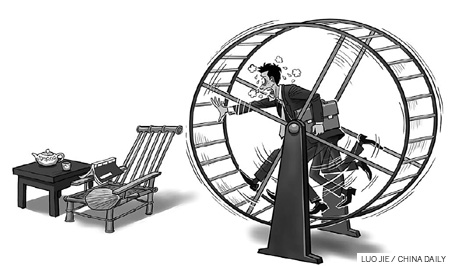
A friend, Yin Taiwu, visited me in the United States recently. He brought me tea from China, and interesting talks about making tea. Seeing him going through the steps of tea-making was a change from buying coffee from Starbucks or a 79-cent Big Gulp from 7-Eleven.
Tea-drinking is rather symbolic of the leisurely and slow life that intellectuals in the East used to enjoy and promote in a different era.
Things today are changing in a way that can shift people of a particular culture from one extreme to another. When Lin Yutang wrote the Art of Living in the early half of the last century, it was obvious that Chinese were still practising such a way of life. Lin criticizes Americans for their faster way of living, which prevents people from getting the best out of life. Today, Lin could be speaking about Chinese using the same words.
| ||||
Over cups of tea, Yin told me that every new employee in his company learns to make tea as his/her job orientation, though his company sells home surveillance products instead of tea. Whenever customers and vendors pay a visit, his employees prepare tea for them through a ritualistic tea ceremony, described as "teaism" by Okakura Kakuzo, author of the Book of Tea.
Yin also uses this kind of learning to train his employees to become better business associates and colleagues, though he confesses that he is not the first to start this kind of training. During the Qing Dynasty (1644-1911), Emperor Kangxi (1662-1723) trained his grandson, Prince Hongli (later Emperor Qianlong - 1711-1799) the same way. Instead of discussing something like Sun Tzu's Art of War, Kangxi used the art of tea-making as part of his successor's training.
To make the best tea, you have to have the right teapot, right kind of water, right temperature and right timing, all working together to produce the best flavor. A story from Feng Menglong's Stories to Awaken the World may be most illustrative of the intricate ways elements act upon each other in the tea-making process.
Wang Anshi (1021-1086), a Song Dynasty (960-1279) politician and scholar, asked scholar, poet Su Shi (1037-1101) to fetch water for him from the middle of the Three Gorges section of the Yangtze River for his Yangxian tea leaves. Su overslept during his trip, and instead of fetching water from that section of the river, he got it from the lower gorge, thinking that it probably wouldn't make much difference. Yet upon tasting the tea made with the water, Wang could immediately tell which section of the Gorges the water was from. This might be a legend, but it is so true when it comes to tea-making.
Tea makes a man exact, and agile. You have to get things orchestrated and optimized to produce a certain result. For the lack of ways to quantify attributes of various elements in tea-making, a tea master develops astute judgment about the tool and the skill for using such tools. Such learning can be easily transferred to other fields.In business, for instance, Yin tries to teach the idea that even high performers can fail if they do not develop affinity with other elements in the work environment, just as one can produce average tea from top-class tea leaves if, for instance, the water or the teapot is not the best for making such tea. He wants his employees to develop synergy with the products, the business platform, the customers, and most importantly, with each other as members of the same team, like leaves in the same pot.
Yin inadvertently uses tea-making to teach activity theory, produced by psychologist Lev SemyonovichVygotsky in the former Soviet Union, further developed in Sweden and widely used in the US, especially in my line of work, educational technology. The theory sees human activities as being complex, socially situated and mediated with the use of particular tools.
Making tea is a changing rather than static activity. We are not talking about adding X amount of A and Y amount of B to produce Z amount of C. The fascinating part is that such elements work on one another in a constant mode of interaction. The change of one element will bring about changes in the entire system to affect the results we set out to achieve. The activity is social, dynamic, and subject to conditions of the people, the tools and the materials we have. The process is so complex that it is more of an art than science. As an art, it defies a formula or a secret recipe.
But if you have read this far, you probably find this elaboration on a theory to be boring. An ounce of story is worth a ton of theories. China has a past full of such stories pregnant with implications for management, especially in the Asian environment. "I do not understand why nobody is paying attention to any of these any more," Yin complained. As Chinese students swarm to learn management theories from developed countries, as if only they hold the secret keys to the inner chambers of management, such teapot stories are forgotten, ignored or dismissed as irrelevant.
Fortunately we still have a few eccentric people like Yin and this author who are willing to learn and retell such stories. In Chinese, there is a proverb, "A teapot is a world". And making good tea can make a world of difference.
The author is an English-Chinese literary translator and instructional designer based in the US.
 转发至微博
转发至微博
0
推荐





 京公网安备 11010502034662号
京公网安备 11010502034662号 